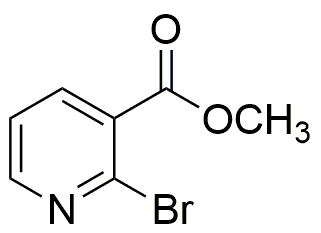Methyl 2-bromonicotinate is widely utilized in research focused on:
- Synthesis of Pharmaceuticals: This compound serves as a key intermediate in the synthesis of various pharmaceutical agents, particularly those targeting neurological disorders. Its bromine atom enhances reactivity, making it easier to form complex molecules.
- Agrochemical Development: It is employed in the development of agrochemicals, including herbicides and pesticides. The compound's unique structure allows for the creation of effective agents that can improve crop yield and pest resistance.
- Material Science: Methyl 2-bromonicotinate is used in the formulation of advanced materials, such as polymers and coatings. Its properties contribute to enhanced durability and chemical resistance in various applications.
- Bioconjugation Techniques: In biochemistry, this compound is utilized for bioconjugation, where it helps attach biomolecules to surfaces or other molecules. This is crucial in developing biosensors and drug delivery systems.
- Research in Organic Chemistry: It serves as a valuable reagent in organic synthesis, allowing researchers to explore new chemical reactions and pathways. Its versatility makes it a staple in laboratories focused on innovative chemical research.
General Information
Properties
Safety and Regulations
Applications
Methyl 2-bromonicotinate is widely utilized in research focused on:
- Synthesis of Pharmaceuticals: This compound serves as a key intermediate in the synthesis of various pharmaceutical agents, particularly those targeting neurological disorders. Its bromine atom enhances reactivity, making it easier to form complex molecules.
- Agrochemical Development: It is employed in the development of agrochemicals, including herbicides and pesticides. The compound's unique structure allows for the creation of effective agents that can improve crop yield and pest resistance.
- Material Science: Methyl 2-bromonicotinate is used in the formulation of advanced materials, such as polymers and coatings. Its properties contribute to enhanced durability and chemical resistance in various applications.
- Bioconjugation Techniques: In biochemistry, this compound is utilized for bioconjugation, where it helps attach biomolecules to surfaces or other molecules. This is crucial in developing biosensors and drug delivery systems.
- Research in Organic Chemistry: It serves as a valuable reagent in organic synthesis, allowing researchers to explore new chemical reactions and pathways. Its versatility makes it a staple in laboratories focused on innovative chemical research.
Documents
Safety Data Sheets (SDS)
The SDS provides comprehensive safety information on handling, storage, and disposal of the product.
Product Specification (PS)
The PS provides a comprehensive breakdown of the product’s properties, including chemical composition, physical state, purity, and storage requirements. It also details acceptable quality ranges and the product's intended applications.
Certificates of Analysis (COA)
Search for Certificates of Analysis (COA) by entering the products Lot Number. Lot and Batch Numbers can be found on a product’s label following the words ‘Lot’ or ‘Batch’.
*Catalog Number
*Lot Number
Certificates Of Origin (COO)
This COO confirms the country where the product was manufactured, and also details the materials and components used in it and whether it is derived from natural, synthetic, or other specific sources. This certificate may be required for customs, trade, and regulatory compliance.
*Catalog Number
*Lot Number
Safety Data Sheets (SDS)
The SDS provides comprehensive safety information on handling, storage, and disposal of the product.
DownloadProduct Specification (PS)
The PS provides a comprehensive breakdown of the product’s properties, including chemical composition, physical state, purity, and storage requirements. It also details acceptable quality ranges and the product's intended applications.
DownloadCertificates of Analysis (COA)
Search for Certificates of Analysis (COA) by entering the products Lot Number. Lot and Batch Numbers can be found on a product’s label following the words ‘Lot’ or ‘Batch’.
*Catalog Number
*Lot Number
Certificates Of Origin (COO)
This COO confirms the country where the product was manufactured, and also details the materials and components used in it and whether it is derived from natural, synthetic, or other specific sources. This certificate may be required for customs, trade, and regulatory compliance.


